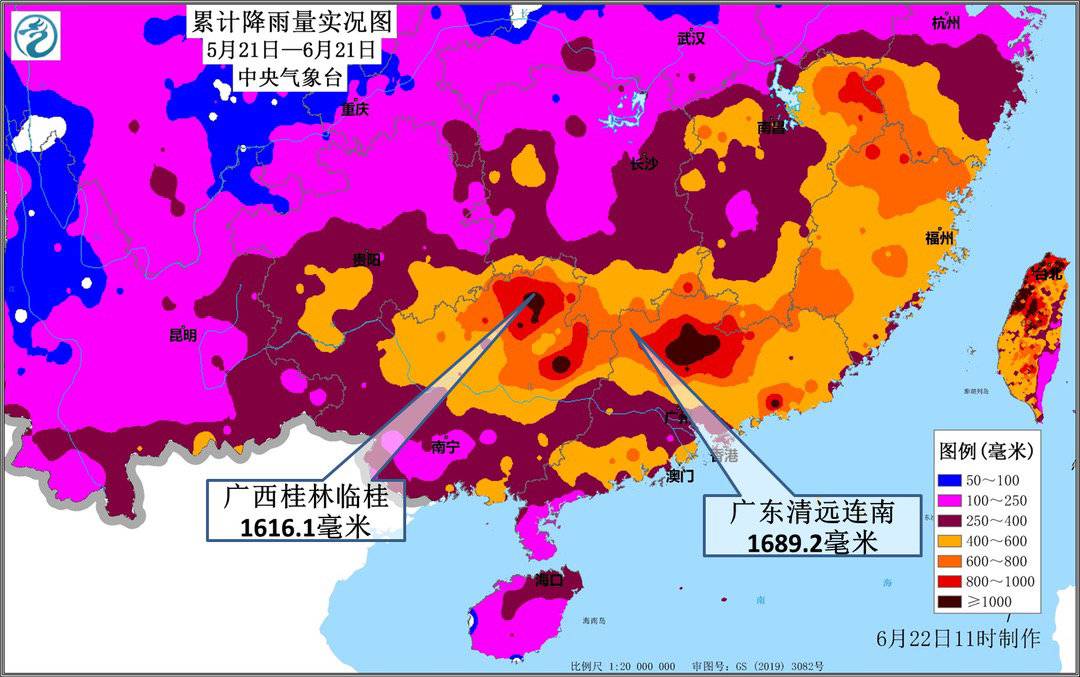South China "Dragon Boat Water", which has caused a large range of urban and rural waterlogging, but still needs to do a good job of geological disasters and other defenses.
Author:Cover news Time:2022.06.24

Cumulative rainfall live map
Cover news reporter Teng Yan
On June 23, the precipitation during the flood season in South China basically ended, but floods and geological disasters were lagging, and relevant disaster defense should be continued.
From late May to mid -June each year is the concentration of precipitation during the flood season in South China. It is also known as "Dragon Boat Water" because of the rainfall period. During this year's "Dragon Boat Water" (May 21 to June 21), the average rainfall of Guangdong, Guangxi, and Hainan was 472.5 mm, which was more than 2nd since 1951. This year, the "Dragon Boat Water" has the characteristics of cumulative rainfall, uneven space distribution, frequent rainfalling process, and many heavy rainfall days. Multi -site rainfall breaks its historical extreme value and has strong extremes. Affected by heavy rainfall, watershed floods, large -scale urban and rural waterlogging and geological disasters in Guangdong and Guangxi appeared.
The heavy rainfall is mainly concentrated in northern Gui, Guangdong. 5月21日至6月21日,广东大部、广西大部、海南岛中东部累计降雨量200至500毫米,广东韶关、清远、河源、汕尾和惠州,广西桂林、柳州、河池、贺州、 There are 600 to 1,000 mm in parts of Wuzhou and Laibin, and more than 1,000 mm in Shaoguan and Qingyuan, Guangxi Guilin and Hezhou, Guangdong; of which Dalima Mountain Town, Liannan County, Guangdong, has a cumulative rainfall of 1689.2 mm and 1652.7 mm in Xinjiang Town, Wengyuan County ; 1616.1 mm in Lingui District, Guilin, Guangxi, 1612.4 mm in Rongshui County, Liuzhou.
The heavy rainfall process is frequent. During the "Dragon Boat Water", South China has 6 consecutive heavy rainfall. The number of heavy rain days in northeast of Guangxi and northern Guangdong is generally 5 to 8 days, and Montana in Guangxi reaches 11 days. In addition, the average rainfall of South China (Guangdong, Guangxi, and Hainan) is 472.5 mm, which is more than 2nd since 1951, second only to 2008.
Among them, the average rainfall of Guangdong was 514.5 mm, which was 54%more than the same period, and it was more than 3rd since 1951. The "Dragon Boat Water" in 18 counties and cities including Lechang and Wengyuan broke the historical record. The average rainfall of Guangxi was 490.8 mm, the most since 1951. 17 counties and cities including Sanjiang, Longsheng, Lingui, and other 17 counties and cities broke the history of the same period. During the period, the rainfall of the three national meteorological observation stations in Xing'an, Huanjiang, and Shaoguan, Huanjiang, and Shaoguan, Huanjiang, and Guangdong, has exceeded the daily rainfall. In addition, the maximum rainfall of the maximum, 3 hours, and 6 hours of Guangxi reached 149.4 mm, 271.6 mm, and 427.6 mm, respectively. The historical value of the district.
In the later period of "Dragon Boat Water", affected by continuous rainfall, watershed floods, urban and rural waterlogging and geological disasters in Guangdong and Guangxi appeared. From May 21st to June 21st, the average rainfall of the Pearl River Basin was 477.8 mm, which was 64%more than the same period of the year, and it was more than 2nd since 1951.
Affected by the continuous heavy rainfall, the number of floods in the Xijiang, on June 6, June 6, 12, and 19 on May 30; two floods occurred on June 14 and 19 on June 14 and 19. At present, the flood of Xijiang No. 4 is evolving, and the water level will maintain a high water level for a long time. The flood of Beijiang No. 2 has developed into a large flood, and the flood prevention situation is extremely severe.
Experts said that the reason for the strong "dragon boat water" this year is mainly due to the frequent cold air activities that affect the eastern region since May. Especially in June, the cold vortex in the Northeast was very active and strengthened to the south. From the south to South China, the temperature of the above -mentioned areas is lower than that of the same period of the year. On the other hand, the Western Pacific subtly high -pressure position is south. The water vapor transportation from the Northwest Pacific and the South China Sea continues to affect South China.
At the same time, with the outbreak and establishment of the summer wind, the southwestern water and vapor guided by the monsoon circulation to South China is also strong. The above reasons have caused abnormal precipitation during the flood season in South China. The forecast shows that from June 23rd to 30th, South China will focus on decentralized rainfall. However, the water content of the soil is saturated, the riverside reservoir runs at a high water level, and floods and geological disasters are lagging, and disaster defense needs to be continued.
- END -
The sun is still the \"protagonist\", and the temperature is \"enthusiastic\"
Three -day forecast in Wuhan City Today: Day Cloudy Tonight: Cloudy ] Maximum temperature: 34 ° C, minimum temperature: 25 ° C humidity: 50-90 %, wind: east wind 3 Central urba
Sun Shaozheng investigated in Hulunbuir City

On June 17, Sun Shaozheng, the party secretary of the autonomous region, investiga...